Uranium
spalling black oxide coat in air | |||||||||||||||||||||||||||||||||||||||||||||||||||||||
| Standard atomic weight Ar°(U) | |||||||||||||||||||||||||||||||||||||||||||||||||||||||
|---|---|---|---|---|---|---|---|---|---|---|---|---|---|---|---|---|---|---|---|---|---|---|---|---|---|---|---|---|---|---|---|---|---|---|---|---|---|---|---|---|---|---|---|---|---|---|---|---|---|---|---|---|---|---|---|
| Uranium in the periodic table | |||||||||||||||||||||||||||||||||||||||||||||||||||||||
| |||||||||||||||||||||||||||||||||||||||||||||||||||||||
kJ/mol | |||||||||||||||||||||||||||||||||||||||||||||||||||||||
| Heat of vaporization | 417.1 kJ/mol | ||||||||||||||||||||||||||||||||||||||||||||||||||||||
| Molar heat capacity | 27.665 J/(mol·K) | ||||||||||||||||||||||||||||||||||||||||||||||||||||||
Vapor pressure
| |||||||||||||||||||||||||||||||||||||||||||||||||||||||
| Atomic properties | |||||||||||||||||||||||||||||||||||||||||||||||||||||||
| Oxidation states | common: +6 −1, Discovery Martin Heinrich Klaproth (1789) | | |||||||||||||||||||||||||||||||||||||||||||||||||||||
| First isolation | Eugène-Melchior Péligot (1841) | ||||||||||||||||||||||||||||||||||||||||||||||||||||||
| Isotopes of uranium | |||||||||||||||||||||||||||||||||||||||||||||||||||||||
| |||||||||||||||||||||||||||||||||||||||||||||||||||||||
Uranium is a
Many contemporary uses of uranium exploit its unique
The 1789
Characteristics

Uranium is a silvery white, weakly radioactive
Uranium metal reacts with almost all non-metallic elements (except noble gases) and their compounds, with reactivity increasing with temperature.[17] Hydrochloric and nitric acids dissolve uranium, but non-oxidizing acids other than hydrochloric acid attack the element very slowly.[11] When finely divided, it can react with cold water; in air, uranium metal becomes coated with a dark layer of uranium oxide.[12] Uranium in ores is extracted chemically and converted into uranium dioxide or other chemical forms usable in industry.
Uranium-235 was the first isotope that was found to be
As little as 15 lb (6.8 kg) of uranium-235 can be used to make an atomic bomb.[18] The nuclear weapon detonated over Hiroshima, called Little Boy, relied on uranium fission. However, the first nuclear bomb (the Gadget used at Trinity) and the bomb that was detonated over Nagasaki (Fat Man) were both plutonium bombs.
Uranium metal has three allotropic forms:[19]
- α (lattice parameters a = 285.4 pm, b = 587 pm, c = 495.5 pm.[20]
- β (tetragonal) stable from 668 to 775 °C (1,234 to 1,427 °F). Tetragonal, space group P42/mnm, P42nm, or P4n2, lattice parameters a = 565.6 pm, b = c = 1075.9 pm.[20]
- γ (body-centered cubic) from 775 °C (1,427 °F) to melting point—this is the most malleable and ductile state. Body-centered cubic, lattice parameter a = 352.4 pm.[20]
Applications
Military
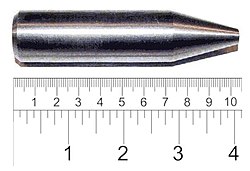
The major application of uranium in the military sector is in high-density penetrators. This ammunition consists of
Depleted uranium is also used as a shielding material in some containers used to store and transport radioactive materials. While the metal itself is radioactive, its high density makes it more effective than
During the later stages of
Civilian
The main use of uranium in the civilian sector is to fuel
Commercial nuclear power plants use fuel that is typically enriched to around 3% uranium-235.[10] The CANDU and Magnox designs are the only commercial reactors capable of using unenriched uranium fuel. Fuel used for United States Navy reactors is typically highly enriched in uranium-235 (the exact values are classified). In a breeder reactor, uranium-238 can also be converted into plutonium-239 through the following reaction:[12]

Before (and, occasionally, after) the discovery of radioactivity, uranium was primarily used in small amounts for yellow glass and pottery glazes, such as uranium glass and in Fiestaware.[24]
The discovery and isolation of radium in uranium ore (pitchblende) by Marie Curie sparked the development of uranium mining to extract the radium, which was used to make glow-in-the-dark paints for clock and aircraft dials.[25][26] This left a prodigious quantity of uranium as a waste product, since it takes three tonnes of uranium to extract one gram of radium. This waste product was diverted to the glazing industry, making uranium glazes very inexpensive and abundant. Besides the pottery glazes, uranium tile glazes accounted for the bulk of the use, including common bathroom and kitchen tiles which can be produced in green, yellow, mauve, black, blue, red and other colors.


Uranium was also used in
The discovery of the radioactivity of uranium ushered in additional scientific and practical uses of the element. The long half-life of uranium-238 (4.47×109 years) makes it well-suited for use in estimating the age of the earliest igneous rocks and for other types of radiometric dating, including uranium–thorium dating, uranium–lead dating and uranium–uranium dating. Uranium metal is used for X-ray targets in the making of high-energy X-rays.[12]
History
Pre-discovery use
The use of
Discovery

The
In 1841,
Henri Becquerel discovered radioactivity by using uranium in 1896.[17] Becquerel made the discovery in Paris by leaving a sample of a uranium salt, K2UO2(SO4)2 (potassium uranyl sulfate), on top of an unexposed photographic plate in a drawer and noting that the plate had become "fogged".[34] He determined that a form of invisible light or rays emitted by uranium had exposed the plate.
During World War I when the Central Powers suffered a shortage of molybdenum to make artillery gun barrels and high speed tool steels, they routinely used ferrouranium alloy as a substitute, as it presents many of the same physical characteristics as molybdenum. When this practice became known in 1916 the US government requested several prominent universities to research the use of uranium in manufacturing and metalwork. Tools made with these formulas remained in use for several decades,[35][36] until the Manhattan Project and the Cold War placed a large demand on uranium for fission research and weapon development.
Fission research

A team led by
On 2 December 1942, as part of the Manhattan Project, another team led by Enrico Fermi was able to initiate the first artificial self-sustained nuclear chain reaction, Chicago Pile-1. An initial plan using enriched uranium-235 was abandoned as it was as yet unavailable in sufficient quantities.[45] Working in a lab below the stands of Stagg Field at the University of Chicago, the team created the conditions needed for such a reaction by piling together 360 tonnes of graphite, 53 tonnes of uranium oxide, and 5.5 tonnes of uranium metal, most of which was supplied by Westinghouse Lamp Plant in a makeshift production process.[37][46]
Nuclear weaponry
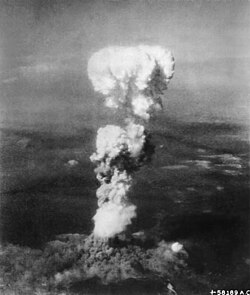
Two types of atomic bomb were developed by the United States during
Reactors

The
Prehistoric naturally occurring fission
In 1972, French physicist
Contamination and the Cold War legacy
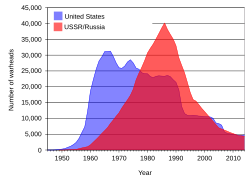
Above-ground
Uranium miners have a higher incidence of
During the
Safety of nuclear facilities in Russia has been significantly improved since the stabilization of political and economical turmoil of the early 1990s. For example, in 1993 there were 29 incidents ranking above level 1 on the
Occurrence
Uranium is a
Uranium's concentration in the Earth's crust is (depending on the reference) 2 to 4 parts per million,[11][22] or about 40 times as abundant as silver.[17] The Earth's crust from the surface to 25 km (15 mi) down is calculated to contain 1017 kg (2×1017 lb) of uranium while the oceans may contain 1013 kg (2×1013 lb).[11] The concentration of uranium in soil ranges from 0.7 to 11 parts per million (up to 15 parts per million in farmland soil due to use of phosphate fertilizers),[63] and its concentration in sea water is 3 parts per billion.[22]
Uranium is more plentiful than antimony, tin, cadmium, mercury, or silver, and it is about as abundant as arsenic or molybdenum.[12][22] Uranium is found in hundreds of minerals, including uraninite (the most common uranium ore), carnotite, autunite, uranophane, torbernite, and coffinite.[12] Significant concentrations of uranium occur in some substances such as phosphate rock deposits, and minerals such as lignite, and monazite sands in uranium-rich ores[12] (it is recovered commercially from sources with as little as 0.1% uranium[17]).
Origin
Like all elements with
Biotic and abiotic
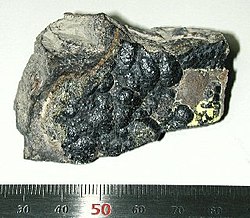
Some bacteria, such as
In nature, uranium(VI) forms highly soluble carbonate complexes at alkaline pH. This leads to an increase in mobility and availability of uranium to groundwater and soil from nuclear wastes which leads to health hazards. However, it is difficult to precipitate uranium as phosphate in the presence of excess carbonate at alkaline pH. A
Plants absorb some uranium from soil. Dry weight concentrations of uranium in plants range from 5 to 60 parts per billion, and ash from burnt wood can have concentrations up to 4 parts per million.[30] Dry weight concentrations of uranium in food plants are typically lower with one to two micrograms per day ingested through the food people eat.[30]
Production and mining
Worldwide production of uranium in 2021 was 48,332 tonnes, of which 21,819 t (45%) was mined in Kazakhstan. Other important uranium mining countries are Namibia (5,753 t), Canada (4,693 t), Australia (4,192 t), Uzbekistan (3,500 t), and Russia (2,635 t).[78]
Uranium ore is mined in several ways:
Commercial-grade uranium can be produced through the reduction of uranium halides with alkali or alkaline earth metals.[12] Uranium metal can also be prepared through electrolysis of KUF
5 or
UF
4, dissolved in molten calcium chloride (CaCl
2) and sodium chloride (NaCl) solution.[12] Very pure uranium is produced through the thermal decomposition of uranium halides on a hot filament.[12]
-
World uranium production (mines) and demand[78]
-
Yellowcake is a concentrated mixture of uranium oxides that is further refined to extract pure uranium.
-
Uranium production 2015, in tonnes[82]
Resources and reserves

It is estimated that 6.1 million tonnes of uranium exists in ores that are economically viable at US$130 per kg of uranium,[83] while 35 million tonnes are classed as mineral resources (reasonable prospects for eventual economic extraction).[84]
Australia has 28% of the world's known uranium ore reserves
Some uranium also originates from dismantled nuclear weapons.[87] For example, in 1993–2013 Russia supplied the United States with 15,000 tonnes of low-enriched uranium within the Megatons to Megawatts Program.[88]
An additional 4.6 billion tonnes of uranium are estimated to be dissolved in
Supplies

In 2005, ten countries accounted for the majority of the world's concentrated uranium oxides: Canada (27.9%), Australia (22.8%), Kazakhstan (10.5%), Russia (8.0%), Namibia (7.5%), Niger (7.4%), Uzbekistan (5.5%), the United States (2.5%), Argentina (2.1%) and Ukraine (1.9%).[95] In 2008, Kazakhstan was forecast to increase production and become the world's largest supplier of uranium by 2009;[96][97] Kazakhstan has dominated the world's uranium market since 2010. In 2021, its share was 45.1%, followed by Namibia (11.9%), Canada (9.7%), Australia (8.7%), Uzbekistan (7.2%), Niger (4.7%), Russia (5.5%), China (3.9%), India (1.3%), Ukraine (0.9%), and South Africa (0.8%), with a world total production of 48,332 tonnes.[78] Most uranium was produced not by conventional underground mining of ores (29% of production), but by in situ leaching (66%).[78][98]
In the late 1960s, UN geologists discovered major uranium deposits and other rare mineral reserves in Somalia. The find was the largest of its kind, with industry experts estimating the deposits at over 25% of the world's then known uranium reserves of 800,000 tons.[99]
The ultimate available supply is believed to be sufficient for at least the next 85 years,[84] though some studies indicate underinvestment in the late twentieth century may produce supply problems in the 21st century.[100] Uranium deposits seem to be log-normal distributed. There is a 300-fold increase in the amount of uranium recoverable for each tenfold decrease in ore grade.[101] In other words, there is little high grade ore and proportionately much more low grade ore available.
Compounds

Oxidation states and oxides
Oxides
Calcined uranium yellowcake, as produced in many large mills, contains a distribution of uranium oxidation species in various forms ranging from most oxidized to least oxidized. Particles with short residence times in a calciner will generally be less oxidized than those with long retention times or particles recovered in the stack scrubber. Uranium content is usually referenced to U
3O
8, which dates to the days of the Manhattan Project when U
3O
8 was used as an analytical chemistry reporting standard.[102]
4·2H
2O) also exist.
The most common forms of uranium oxide are triuranium octoxide (U
3O
8) and UO
2.[104] Both oxide forms are solids that have low solubility in water and are relatively stable over a wide range of environmental conditions. Triuranium octoxide is (depending on conditions) the most stable compound of uranium and is the form most commonly found in nature. Uranium dioxide is the form in which uranium is most commonly used as a nuclear reactor fuel.[104] At ambient temperatures, UO
2 will gradually convert to U
3O
8. Because of their stability, uranium oxides are generally considered the preferred chemical form for storage or disposal.[104]
Aqueous chemistry

Salts of many
Unlike the uranyl salts of uranium and polyatomic ion uranium-oxide cationic forms, the uranates, salts containing a polyatomic uranium-oxide anion, are generally not water-soluble.
Carbonates
The interactions of carbonate anions with uranium(VI) cause the Pourbaix diagram to change greatly when the medium is changed from water to a carbonate containing solution. While the vast majority of carbonates are insoluble in water (students are often taught that all carbonates other than those of alkali metals are insoluble in water), uranium carbonates are often soluble in water. This is because a U(VI) cation is able to bind two terminal oxides and three or more carbonates to form anionic complexes.
 |
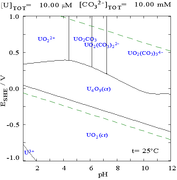 |
| Uranium in a non-complexing aqueous medium (e.g. perchloric acid/sodium hydroxide).[106] |
Uranium in carbonate solution |
 |
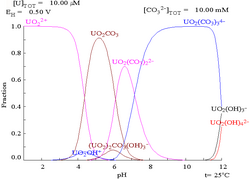 |
| Relative concentrations of the different chemical forms of uranium in a non-complexing aqueous medium (e.g. perchloric acid/sodium hydroxide).[106] |
Relative concentrations of the different chemical forms of uranium in an aqueous carbonate solution.[106] |
Effects of pH
The uranium fraction diagrams in the presence of carbonate illustrate this further: when the pH of a uranium(VI) solution increases, the uranium is converted to a hydrated uranium oxide hydroxide and at high pHs it becomes an anionic hydroxide complex.
When carbonate is added, uranium is converted to a series of carbonate complexes if the pH is increased. One effect of these reactions is increased solubility of uranium in the pH range 6 to 8, a fact that has a direct bearing on the long term stability of spent uranium dioxide nuclear fuels.
Hydrides, carbides and nitrides
Uranium metal heated to 250 to 300 °C (482 to 572 °F) reacts with hydrogen to form uranium hydride. Even higher temperatures will reversibly remove the hydrogen. This property makes uranium hydrides convenient starting materials to create reactive uranium powder along with various uranium carbide, nitride, and halide compounds.[107] Two crystal modifications of uranium hydride exist: an α form that is obtained at low temperatures and a β form that is created when the formation temperature is above 250 °C.[107]
3O
8.[107] Carbides of uranium include uranium monocarbide (UC), uranium dicarbide (UC
2), and diuranium tricarbide (U
2C
3). Both UC and UC
2 are formed by adding carbon to molten uranium or by exposing the metal to carbon monoxide at high temperatures. Stable below 1800 °C, U
2C
3 is prepared by subjecting a heated mixture of UC and UC
2 to mechanical stress.[108] Uranium nitrides obtained by direct exposure of the metal to nitrogen include uranium mononitride (UN), uranium dinitride (UN
2), and diuranium trinitride (U
2N
3).[108]
Halides

All uranium fluorides are created using uranium tetrafluoride (UF
4); UF
4 itself is prepared by hydrofluorination of uranium dioxide.[107] Reduction of UF
4 with hydrogen at 1000 °C produces uranium trifluoride (UF
3). Under the right conditions of temperature and pressure, the reaction of solid UF
4 with gaseous uranium hexafluoride (UF
6) can form the intermediate fluorides of U
2F
9, U
4F
17, and UF
5.[107]
At room temperatures, UF
6 has a high vapor pressure, making it useful in the gaseous diffusion process to separate the rare uranium-235 from the common uranium-238 isotope. This compound can be prepared from uranium dioxide and uranium hydride by the following process:[107]
- UO
2 + 4 HF → UF
4 + 2 H
2O (500 °C, endothermic) - UF
4 + F
2 → UF
6 (350 °C, endothermic)
The resulting UF
6, a white solid, is highly
One method of preparing
3) while the higher chlorides of uranium are prepared by reaction with additional chlorine.[107]
Isotopes
Uranium, like all elements with an atomic number greater than 82, has no
Uranium-238 is the most stable isotope of uranium, with a half-life of about 4.463×109 years,
Uranium-235 has a half-life of about 7.04×108 years; it is the next most stable uranium isotope after 238U and is also predominantly an alpha emitter, decaying to thorium-231.
Uranium-236 has a half-life of 2.342×107 years[7] and is not found in significant quantities in nature. The half-life of uranium-236 is too short for it to be primordial, though it has been identified as an extinct progenitor of its alpha decay daughter, thorium-232.[67] Uranium-236 occurs in spent nuclear fuel when neutron capture on 235U does not induce fission, or as a decay product of plutonium-240. Uranium-236 is not fertile, as three more neutron captures are required to produce fissile 239Pu, and is not itself fissile; as such, it is considered long-lived radioactive waste.[115]
Uranium-234 is a member of the uranium series and occurs in equilibrium with its progenitor, 238U; it undergoes alpha decay with a half-life of 245,500 years[7] and decays to lead-206 through a series of relatively short-lived isotopes.
Uranium-233 undergoes alpha decay with a half-life of 160,000 years and, like 235U, is fissile.-205.
All isotopes from 232U to 236U inclusive have minor
In total, 28 isotopes of uranium have been identified, ranging in mass number from 214[119] to 242, with the exception of 220.[7][120] Among the uranium isotopes not found in natural samples or nuclear fuel, the longest-lived is 230U, an alpha emitter with a half-life of 20.23 days.[7] This isotope has been considered for use in targeted alpha-particle therapy (TAT).[121] All other isotopes have half-lives shorter than one hour, except for 231U (half-life 4.2 days) and 240U (half-life 14.1 hours).[7] The shortest-lived known isotope is 221U, with a half-life of 660 nanoseconds, and it is expected that the hitherto unknown 220U has an even shorter half-life.[122] The proton-rich isotopes lighter than 232U primarily undergo alpha decay, except for 229U and 231U, which decay to protactinium isotopes via positron emission and electron capture, respectively; the neutron-rich 240U, 241U, and 242U undergo beta decay to form neptunium isotopes.[7][120]
Enrichment

In nature, uranium is found as uranium-238 (99.2742%) and uranium-235 (0.7204%).
To be considered 'enriched', the uranium-235 fraction should be between 3% and 5%.[123] This process produces huge quantities of uranium that is depleted of uranium-235 and with a correspondingly increased fraction of uranium-238, called depleted uranium or 'DU'. To be considered 'depleted', the 235U concentration should be no more than 0.3%.[124] The price of uranium has risen since 2001, so enrichment tailings containing more than 0.35% uranium-235 are being considered for re-enrichment, driving the price of depleted uranium hexafluoride above $130 per kilogram in July 2007 from $5 in 2001.[124]
The gas centrifuge process, where gaseous uranium hexafluoride (UF
6) is separated by the difference in molecular weight between 235UF6 and 238UF6 using high-speed centrifuges, is the cheapest and leading enrichment process.[34] The gaseous diffusion process had been the leading method for enrichment and was used in the Manhattan Project. In this process, uranium hexafluoride is repeatedly diffused through a silver-zinc membrane, and the different isotopes of uranium are separated by diffusion rate (since uranium-238 is heavier it diffuses slightly slower than uranium-235).[34] The molecular laser isotope separation method employs a laser beam of precise energy to sever the bond between uranium-235 and fluorine. This leaves uranium-238 bonded to fluorine and allows uranium-235 metal to precipitate from the solution.[10] An alternative laser method of enrichment is known as atomic vapor laser isotope separation (AVLIS) and employs visible tunable lasers such as dye lasers.[125] Another method used is liquid thermal diffusion.[11]
The only significant deviation from the 235U to 238U ratio in any known natural samples occurs in
Human exposure
A person can be exposed to uranium (or its
Most ingested uranium is excreted during digestion. Only 0.5% is absorbed when insoluble forms of uranium, such as its oxide, are ingested, whereas absorption of the more soluble uranyl ion can be up to 5%.[30] However, soluble uranium compounds tend to quickly pass through the body, whereas insoluble uranium compounds, especially when inhaled by way of dust into the lungs, pose a more serious exposure hazard. After entering the bloodstream, the absorbed uranium tends to bioaccumulate and stay for many years in bone tissue because of uranium's affinity for phosphates.[30] Incorporated uranium becomes uranyl ions, which accumulate in bone, liver, kidney, and reproductive tissues.[129]
Radiological and chemical toxicity of uranium combine by the fact that elements of high atomic number Z like uranium exhibit phantom or secondary radiotoxicity through absorption of natural background gamma and X-rays and re-emission of photoelectrons, which in combination with the high affinity of uranium to the phosphate moiety of DNA cause increased single and double strand DNA breaks.[130]
Uranium is not absorbed through the skin, and alpha particles released by uranium cannot penetrate the skin.[27]
Uranium can be decontaminated from steel surfaces[131] and aquifers.[132][133]
Effects and precautions
Normal functioning of the
Although accidental inhalation exposure to a high concentration of uranium hexafluoride has resulted in human fatalities, those deaths were associated with the generation of highly toxic hydrofluoric acid and uranyl fluoride rather than with uranium itself.[142] Finely divided uranium metal presents a fire hazard because uranium is pyrophoric; small grains will ignite spontaneously in air at room temperature.[12]
Uranium metal is commonly handled with gloves as a sufficient precaution.[143] Uranium concentrate is handled and contained so as to ensure that people do not inhale or ingest it.[143]
See also
- K-65 residues
- List of countries by uranium production
- List of countries by uranium reserves
- List of uranium projects
- Lists of nuclear disasters and radioactive incidents
- Nuclear and radiation accidents and incidents
- Nuclear engineering
- Nuclear fuel cycle
- Nuclear physics
- Quintuple bond (earlier thought to be a phi bond), in the molecule U2
- Thorium fuel cycle
- World Uranium Hearing
Notes
- ^ The thermal expansion is anisotropic: the coefficients for each crystal axis (at 20 °C) are αa = 25.27×10−6/K, αb = 0.76×10−6/K, αc = 20.35×10−6/K, and αaverage = αvolume/3 = 15.46×10−6/K.
References
- ^ "Standard Atomic Weights: Uranium". CIAAW. 1999.
- ISSN 1365-3075.
- ^ ISBN 978-1-62708-155-9.
- PMID 31276242.
- ISBN 978-9048131464.
- ^ ISBN 978-0-08-037941-8.
- ^ .
- ^ Magurno, B.A.; Pearlstein, S, eds. (1981). Proceedings of the conference on nuclear data evaluation methods and procedures. BNL-NCS 51363, vol. II (PDF). Upton, NY (USA): Brookhaven National Lab. pp. 835 ff. Retrieved 6 August 2014.
- ^ "Uranium". Encyclopaedia Britannica. Retrieved 22 April 2017.
- ^ a b c d e Emsley 2001, p. 479.
- ^ ISBN 978-0-07-142957-3.
- ^ ISBN 978-0-8493-0481-1.
- ^ "Uranium". Royal Society of Chemistry.
- ^ "Lead". Royal Society of Chemistry.
- ^ "Tungsten". Royal Society of Chemistry.
- ^ "Gold". Royal Society of Chemistry.
- ^ a b c d e f g "uranium". Columbia Electronic Encyclopedia (6th ed.). Columbia University Press. Archived from the original on 27 July 2011. Retrieved 27 September 2008.
- ^ a b c d e "uranium". Encyclopedia of Espionage, Intelligence, and Security. The Gale Group, Inc. Archived from the original on 27 July 2011. Retrieved 27 September 2008.
- ISBN 978-0-470-40835-3.
- ^ ISBN 978-1-4020-3555-5. Archived from the original(PDF) on 7 March 2016.
- ^ "Development of DU Munitions". Depleted Uranium in the Gulf (II). Gulflink, official website of Force Health Protection & Readiness. 2000.
- ^ a b c d e Emsley 2001, p. 480.
- ^ "Nuclear Weapon Design". Federation of American Scientists. 1998. Archived from the original on 26 December 2008. Retrieved 19 February 2007.
- ^ "Statement regarding the Good Morning America broadcast," The Homer Laughlin China Co. Archived 1 April 2012 at the Wayback Machine, 16 March 2011, accessed 25 March 2012.
- ^ "Dial R for radioactive – 12 July 1997 – New Scientist". Newscientist.com. Retrieved 12 September 2008.
- ^ "Uranium Mining". Atomic Heritage Foundation. Retrieved 23 December 2020.
- ^ a b "EPA Facts about Uranium" (PDF). U.S. Environmental Protection Agency. Archived from the original (PDF) on 29 November 2014. Retrieved 20 September 2014.
- ^ "Uranium Containing Dentures (ca. 1960s, 1970s)". ORAU Museum of Radiation and Radioactivity. Oak Ridge Associated Universities. 1999. Retrieved 11 October 2021.
- ^ Emsley 2001, p. 482.
- ^ a b c d e f g h i j Emsley 2001, p. 477.
- ^ Klaproth, M. H. (1789). "Chemische Untersuchung des Uranits, einer neuentdeckten metallischen Substanz". Chemische Annalen. 2: 387–403.
- ^ "Uranium". The American Heritage Dictionary of the English Language (4th ed.). Houghton Mifflin Company. Archived from the original on 27 July 2011. Retrieved 15 January 2007.
- ^ Péligot, E.-M. (1842). "Recherches Sur L'Uranium". Annales de chimie et de physique. 5 (5): 5–47.
- ^ a b c d Emsley 2001, p. 478.
- ^ "The Electric Journal". Westinghouse Club. 10 April 1920 – via Google Books.
- ^ Gillett, Horace Wadsworth; Mack, Edward Lawrence (10 April 1917). Preparation of ferro-uranium. Technical Paper 177 – U.S. Bureau of Mines. U.S. Govt. print. off. – via Google Books.
- ^ a b c d e f Seaborg 1968, p. 773.
- ^ Fermi, Enrico (12 December 1938). "Artificial radioactivity produced by neutron bombardment: Nobel Lecture" (PDF). Royal Swedish Academy of Sciences. Archived from the original (PDF) on 9 August 2018. Retrieved 14 June 2017.
- .
- ^ Nigro, M. (2004). "Hahn, Meitner e la teoria della fissione" (PDF). Archived from the original (PDF) on 25 March 2009. Retrieved 5 May 2009.
- ^ van der Krogt, Peter. "Elementymology & Elements Multidict". Retrieved 5 May 2009.
- S2CID 4188874.
- ^ "Alfred O. C. Nier". www.aps.org. Archived from the original on 19 July 2018. Retrieved 4 December 2016.
- ^ Manfred Popp (21 September 2016). "Wissenschaftsgeschichte: Hitlers Atombombe – warum es sie nicht gab – Spektrum der Wissenschaft". Spektrum.de. Retrieved 25 February 2022.
- ^ "Chicago Pile One". large.stanford.edu. Retrieved 4 December 2016.
- PMID 17746246. Retrieved 23 March 2013.
- ISBN 0-7837-9349-9
- ^ "Reactors Designed by Argonne National Laboratory: Fast Reactor Technology". U.S. Department of Energy, Argonne National Laboratory. 2012. Retrieved 25 July 2012.
- ^ "History and Success of Argonne National Laboratory: Part 1". U.S. Department of Energy, Argonne National Laboratory. 1998. Archived from the original on 26 September 2006. Retrieved 28 January 2007.
- ^ "Reactors Designed by Argonne National Laboratory: Light Water Reactor Technology Development". U.S. Department of Energy, Argonne National Laboratory. 2012. Retrieved 25 July 2012.
- ^ "1956: Queen switches on nuclear power". BBC News. 17 October 1956. Retrieved 28 June 2006.
- ^ "STR (Submarine Thermal Reactor) in "Reactors Designed by Argonne National Laboratory: Light Water Reactor Technology Development"". U.S. Department of Energy, Argonne National Laboratory. 2012. Retrieved 25 July 2012.
- ^ a b "Oklo: Natural Nuclear Reactors". Office of Civilian Radioactive Waste Management. Archived from the original on 3 June 2004. Retrieved 28 June 2006.
- .
- ^ "The Worst Nuclear Disasters". Time. 25 March 2009. Archived from the original on 28 March 2009. Retrieved 24 May 2010.
- PMID 10738707.
- PMID 12197966.
- PMID 9166072. (3000 examinations from 18 hospitals)
- ^ Russia's Nuclear Fuel Cycle. World Nuclear Association. Updated December 2021.
- ISBN 978-0-19-850340-8.
- ^ Biever, Celeste (27 July 2005). "First measurements of Earth's core radioactivity". New Scientist. Retrieved 7 July 2022.
- ^ "Potassium-40 heats up Earth's core". physicsworld.com. 7 May 2003. Retrieved 14 January 2007.
- ^ Schnug, E., Sun, Y., Zhang, L., Windmann, H., Lottermoser, B.G., Ulrich, A. E., Bol, R., Makeawa, M., and Haneklaus, S.H. (2023) "Elemental loads with phosphate fertilizers – a constraint for soil productivity?" In: Bolan, N.S. and Kirkham, M.B. (eds.) Managing Soil Constraints for Sustaining Productivity. CRC Press.
- ^ "History/Origin of Chemicals". NASA. Retrieved 1 January 2013.
- .
- ISBN 978-0226109534.
- ^ .
- ^
Tissot, François L. H.; Dauphas, Nicolas; Grossmann, Lawrence (4 March 2016). "Origin of uranium isotope variations in early solar nebula condensates". Science Advances. 2 (3): e1501400. PMID 26973874.
- .
- PMID 25874721.
- PMID 16124300.
- PMID 31934763.
- ^ Emsley 2001, pp. 476 and 482.
- PMID 1496397.
- PMID 14532040.
- PMID 20019082.
- ^
Nilgiriwala, K.S.; Alahari, A.; Rao, A. S. & Apte, S.K. (2008). "Cloning and Overexpression of Alkaline Phosphatase PhoK from Sphingomonas sp. Strain BSAR-1 for Bioprecipitation of Uranium from Alkaline Solutions". Applied and Environmental Microbiology. 74 (17): 5516–5523. PMID 18641147.
- ^ a b c d "World Uranium Mining". World Nuclear Association. Retrieved 31 January 2023.
- ^ Seaborg 1968, p. 774.
- ^ "Athabasca Basin, Saskatchewan". Retrieved 4 September 2009.
- ISBN 978-0-8493-6804-2.
- ^ "Uranium production". Our World in Data. Retrieved 6 March 2020.
- ^ a b "Uranium Supplies: Supply of Uranium – World Nuclear Association". www.world-nuclear.org.
- ^ a b "Global Uranium Resources to Meet Projected Demand". International Atomic Energy Agency. 2006. Retrieved 29 March 2007.
- ^ "Uranium Mining and Processing in South Australia". South Australian Chamber of Mines and Energy. 2002. Archived from the original on 6 January 2012. Retrieved 14 January 2007.
- ^ Ngoupana, P.-M.; Felix, B. (2011). Barker, A. (ed.). "Areva suspends CAR uranium mine project". Central African Republic News. Retrieved 7 March 2020.
- ^ "Military Warheads as a Source of Nuclear Fuel". World-nuclear.org. Retrieved 24 May 2010.
- ^ "Megatons to Megawatts". U.S. Enrichment Corp. Archived from the original on 16 July 2008.
- ^ "Uranium recovery from Seawater". Japan Atomic Energy Research Institute. 23 August 1999. Archived from the original on 17 October 2009. Retrieved 3 September 2008.
- ^ "How long will nuclear energy last?". 12 February 1996. Archived from the original on 10 April 2007. Retrieved 29 March 2007.
- .
- ^ "ORNL technology moves scientists closer to extracting uranium from seawater". Oak Ridge National Laboratory, United States. 21 August 2012. Archived from the original on 25 August 2012. Retrieved 22 February 2013.
- ^ "Fueling nuclear power with seawater". Pnnl.gov. 21 August 2012. Archived from the original on 25 August 2012. Retrieved 22 February 2013.
- ^ "NUEXCO Exchange Value (Monthly Uranium Spot)". Archived from the original on 12 December 2007.
- ^ "World Uranium Production". UxC Consulting Company, LLC. Archived from the original on 27 February 2007. Retrieved 11 February 2007.
- ^ Mithridates (24 July 2008). "Page F30: Kazakhstan to surpass Canada as the world's largest producer of uranium by last year (2009)". Mithridates.blogspot.com. Archived from the original on 4 March 2010. Retrieved 12 September 2008.
- ^ "Kazakistan uranyum üretimini artıracak". Zaman.com.tr (in Turkish). Zaman Gazetesi. 28 July 2008. Archived from the original on 13 January 2009. Retrieved 12 September 2008.
- ^ "In Situ Leach Mining (ISL) of Uranium – World Nuclear Association". www.world-nuclear.org. Retrieved 6 May 2021.
- ^ "Big Uranium Find Announced in Somalia". The New York Times. 16 March 1968. Retrieved 16 May 2014.
- ^ "Lack of fuel may limit U.S. nuclear power expansion". Massachusetts Institute of Technology. 21 March 2007. Retrieved 29 March 2007.
- OSTI 6665051.
- OCLC 1223058470.
- ^ Seaborg 1968, p. 779.
- ^ a b c "Chemical Forms of Uranium". Argonne National Laboratory. Archived from the original on 22 September 2006. Retrieved 18 February 2007.
- ^ a b Seaborg 1968, p. 778.
- ^ a b c d Puigdomenech, Ignasi (2004) Hydra/Medusa Chemical Equilibrium Database and Plotting Software. KTH Royal Institute of Technology
- ^ a b c d e f g h i j Seaborg 1968, p. 782.
- ^ a b Seaborg 1968, p. 780.
- ISBN 978-0-07-244848-1. Archived from the original(PDF) on 4 October 2016. Retrieved 4 July 2016.
- S2CID 14814446.
- ^ a b c The occurrence of plutonium-244 as a primordial nuclide is disputed, though some reports of its detection have also been attributed to infall from the interstellar medium.[112][113]
- .
- PMID 25601158.
- .
- PMID 24309010.
- ^ a b Near Term and Promising Long Term Options for the Deployment of Thorium Based Nuclear Energy (PDF) (Report). Vienna: International Atomic Energy Agency. 2022.
- ^ a b Forsburg, C. W.; Lewis, L. C. (24 September 1999). "Uses For Uranium-233: What Should Be Kept for Future Needs?" (PDF). Ornl-6952. Oak Ridge National Laboratory.
- ISBN 978-0-471-91515-7.
- S2CID 231627674. Retrieved 15 May 2021.
- ^ S2CID 257976576.
- PMID 29757620.
- S2CID 12184696.
- ^ "Uranium Enrichment". Argonne National Laboratory. Archived from the original on 24 January 2007. Retrieved 11 February 2007.
- ^ a b Diehl, Peter. "Depleted Uranium: a by-product of the Nuclear Chain". Laka Foundation. Archived from the original on 13 January 2013. Retrieved 31 July 2009.
- ISBN 978-0-12-222700-4. Archived from the originalon 17 September 2010.
- ^ "Radionuclide Basics: Uranium". U.S. Environmental Protection Agency. 16 February 2023. Retrieved 19 April 2023.
- ^ "ToxFAQ for Uranium". Agency for Toxic Substances and Disease Registry. 18 March 2014. Retrieved 19 April 2023.
- ^ "CDC – NIOSH Pocket Guide to Chemical Hazards – Uranium (insoluble compounds, as U)". National Institute for Occupational Safety and Health. 30 October 2019. Retrieved 19 April 2023.
- OCLC 609844907.
- ISBN 978-90-5782-193-6
- PMID 16053105.
- S2CID 246988421.
- S2CID 251999162.
- S2CID 9357795.
- ^ Agency for Toxic Substances and Disease Registry (ATSDR) (February 2013). "2. Relevance to Public Health" (PDF). Toxicological Profile for Uranium (Report). Atlanta, GA: U.S. Department of Health and Human Services, Public Health Service. pp. 11–38. CAS# 7440-61-1.
- PMID 16124873.
- S2CID 25310165.
- PMID 28520643.
- ^ "Public Health Statement for Uranium" (PDF). CDC. Retrieved 5 May 2023.
- ^ Radon Exposures to Workers at the Fernald Feed Materials Production Center. Page reviewed: April 8, 2020. U.S. National Institute for Occupational Safety and Health (NIOSH)
- ^ Chart of the Nuclides, US Atomic Energy Commission 1968
- ISBN 978-0-7817-2845-4.
- ^ a b "Radiation Fact Sheets #27, Uranium (U)". Washington State Department of Health, Office of Radiation Protection. 2010. Archived from the original on 28 September 2011. Retrieved 23 August 2011.
Sources cited
- ISBN 978-0-19-850340-8.
- LCCN 68029938.
External links
- Nuclear fuel data and analysis from the U.S. Energy Information Administration
- World Uranium deposit maps
- Dittmar, William (1888). . Encyclopædia Britannica. Vol. XXIV (9th ed.). p. 7.
- Annotated bibliography for uranium from the Alsos Digital Library
- NLM Hazardous Substances Databank – Uranium, Radioactive
- CDC – NIOSH Pocket Guide to Chemical Hazards
- ATSDR Case Studies in Environmental Medicine: Uranium Toxicity Archived 4 February 2016 at the Department of Health and Human Services
- Uranium at The Periodic Table of Videos(University of Nottingham)

![World uranium production (mines) and demand[78]](http://upload.wikimedia.org/wikipedia/commons/thumb/7/75/U_production-demand.png/500px-U_production-demand.png)

![Uranium production 2015, in tonnes[82]](http://upload.wikimedia.org/wikipedia/commons/thumb/9/9a/Uranium_production%2C_OWID.svg/500px-Uranium_production%2C_OWID.svg.png)

